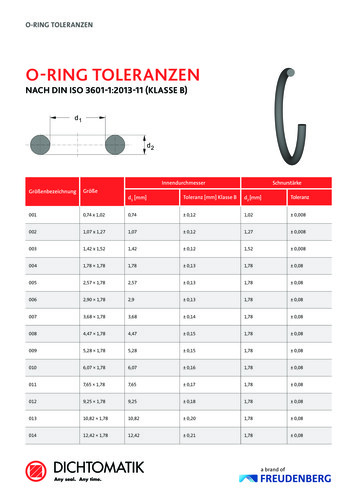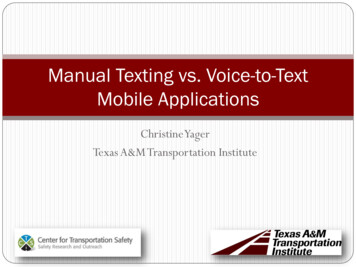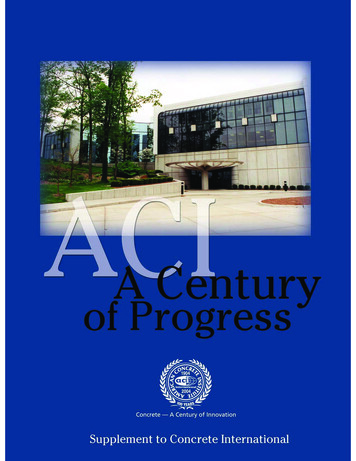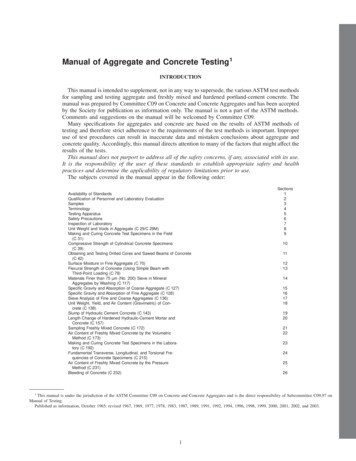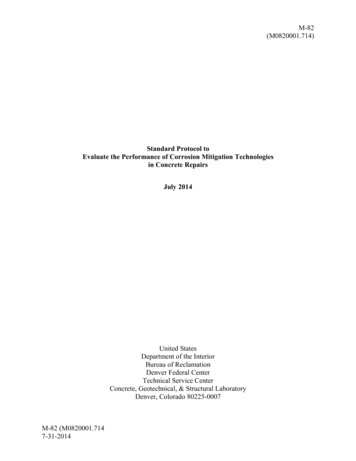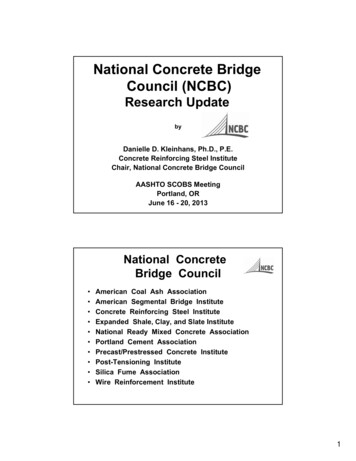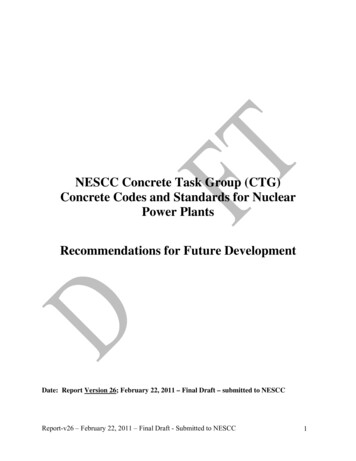
Transcription
NESCC Concrete Task Group (CTG)Concrete Codes and Standards for NuclearPower PlantsRecommendations for Future DevelopmentDate: Report Version 26; February 22, 2011 – Final Draft – submitted to NESCCReport-v26 – February 22, 2011 – Final Draft - Submitted to NESCC1
Preparation of This ReportThis report was prepared by the NESCC Concrete Task Group (CTG). Membership on the CTGwas open, i.e., no attempt was made to limit the membership. Efforts were made to includerepresentatives from standards development organizations (SDO) and the construction industrywho are involved in new nuclear power plant construction.Chair: The Chair of the CTG was Chiara F. Ferraris, National Institute of Standards andTechnology, Gaithersburg (USA)The table below lists the organization that participated and their representatives.Organization representedName(in alphabetical order)ACIAISCAMECAmerenUE Callaway Nuclear PlantAREVAASMEASTMBASFBechtel PowerCarrasquillo AssociatesCommision Nacional de Seguridad NuclearConsultantDOEDominion Virginia PowerDuke EnergyEPRIExelonMatthew SenecalDaniel KaufmanCorina AldeaTom GrotheTodd OswaldByran ErlerAnthony Quinn & Joe KouryEmmanuel AttiogbeJaveed Munshi & Sanj MalushteRamón L. CarrasquilloPablo Ruiz LopezTony FioratoTom Miller & Mathew HutmakerChuck ZalesiakSteven LeflerMaria GuimaraesJanowiak, RonaldDavid StokesFMC Lithium DivisionICA FluorJuan Carlos SantosINLKevin WilkinsJ.D. Stevenson, Consulting Engineer (Member ACI- John Stevenson359 and ASCE-4)Los Alamos National LaboratoryMichael SalmonNCMAJason ThompsonNISTChiara Ferraris (Chair)Purdue Univ.Amit VarmaSargent & Lundy/ Chair 359Arthur "Curt" EberhardtSavannah River Remediation, LLC/ Chair 349Ranjit Bandyopadhyay (deceased)Southern CompanyPartha GhosalUnistarJay Leininger & Olivier MalletUniversity of KansasDavid DarwinKansas State UniversityJ.K. ShultisUS-NRCHerman GravesWestinghouseKeith CooglerReport-v26 – February 22, 2011 – Final Draft - Submitted to NESCC2
Table of contents1.Introduction. 42.Objectives overview. 53.Discussion of Standards Development Organizations (SDO) and relevant documents . 73.1.American Concrete Institute (ACI).73.1.1. Recommendations for ACI 318, 349, and 359 . 83.1.2. Recommendations for other ACI documents. 143.1.3. Status of Nuclear Inspector Certification Program. 163.2.American Institute of Steel Construction (AISC).183.3.Coordination ACI and ASME.193.4.American National Standards Institute/American Nuclear Society (ANSI/ANS) .193.5.American Society of Civil Engineers (ASCE).203.6.Electric Power Research Institute (EPRI).203.7.Nuclear Energy Institute, NEI.213.8.National Fire Protection Association (NFPA) .213.9.Coordination DOE, NRC and SDOs.214.Issues unrelated to SDOs . 244.1.Materials .244.2.Implementation of new technologies .254.3.Foreign standards and Codes .264.3.1. General. 264.3.2. Information for specific countries. 275.Research Needs . 325.1.High Strength reinforcing steel.325.2.Concrete Radiation Shielding .335.3.Durability of concrete .345.4.Performance-based design .345.5.Ultra-High Performance Concretes (UHPC) .355.6.Use of Lapped Splices in Regions of Low Biaxial Tension .355.7.Temperature Loading on Concrete .355.8.Present Research .365.8.1. Westinghouse-Bechtel: Steel Composite (SC) walls. 365.9.Others Research needs .386.Summary . 39Appendix A: Request for CTG Appendix B: Load combinations suggestions Appendix C: Discussion of Appendix E of ACI 349/1R-07 .Appendix D: Hybrid Steel and Concrete Containment Design Standard .Report-v26 – February 22, 2011 – Final Draft - Submitted to NESCC3
123456789101112131. IntroductionThe Nuclear Energy Standards Coordination Collaborative (NESCC) is a joint initiative ofthe American National Standards Institute (ANSI) and the National Institute for Standards andTechnology (NIST) to identify and respond to the current needs of the nuclear industry. NESCCwas created in June 2009. More details on NESCC and its activities can be found on thefollowing website:(http://www.ansi.org/standards activities/standards boards panels/nescc/overview.aspx?menuid 3 )In December 2009, NESCC formed a task group “Concrete Codes and Standards forNuclear Power Plants”, referred to as the “Concrete Task group” (CTG) in this report. Therequest (Appendix A) for the formation of the task group had the following scope: Establish coordination and consistency of safety and non-safety related concreterequirements in nuclear power plants.1415 Identify new design requirements for safety related concrete components, anddevelop a plan to incorporate these new requirements into codes and standards.16171819 Identify and review all U.S. Nuclear Regulatory Commission (NRC) Regulatorydocuments related to concrete for nuclear power plants. Note that this goal wastoo ambitious and cannot be achieved by this TG. Nevertheless, NRC is in theprocess to update most Regulatory Guides.2021222324The CTG started immediately recruiting members to solicit active participation ofrepresentatives from relevant Standards Development Organizations (SDO) and concreteindustry organizations involved in the construction of new nuclear power plants. At theconclusion of its work, there were 28 members representing 31 organizations including NRC andNIST.252627282930313233The group met by virtual meetings regularly, and face-to-face at the ACI Convention inChicago (April 2010). Each member was asked to contribute on topics related to their expertiseand to review the report. A formal vote was conducted to ensure that the concerns of all memberswere addressed. As of February 22, 2011, 6 ballots were conducted by e-mail. Each time areport and a ballot form were sent to members and reviewers. The comments were, as assignedby the voter, either Primary (P) comments identify technical issues, or Editorial (E) commentsidentify editorial issues. All CTG members were invited to comments and resolve the Pcomments. The Chair addressed the E comments directly. After each ballot, a new report in trackchanges was sent to the members to address the primary comments.3435The report has three main sections to examine issues relevant to the construction of newnuclear power plants:36373839o Issues related to SDOso Issues unrelated to SDOso Research needsIt should be noted that this report is limited to discussion of concrete construction.Report-v26 – February 22, 2011 – Final Draft - Submitted to NESCC4
2. Objectives overview123456Four objectives were listed in the request for the CTG (Appendix A). A short summary isgiven here, along with references to appropriate sections.1)Review the Mattson report 1 , NRC NUREG CR 5973 2 , and all NRC-regulatory documentsto identify all references to concrete codes and standards applied to both material andstructural specifications for nuclear power plants;78910The Mattson report and the NUREG/CR-5973 report list standards and codesreferenced in NRC documents. However, they did not reflect the major gaps in thestandards and codes in the nuclear industry. The objective of the NUREG/CR-5973 reportwas to provide a list of standards from SDOs related to nuclear facilities.1112131415The list of ASTM standards provided in those documents was not examined in detail,because NRC does not reference them directly in their documents. Their usage isimplemented by referencing other SDO’s standards3 (codes, specifications, criteria, andguidelines). In Section 3, there is an analysis of the gaps in the concrete standards,specifications, and codes for SDO’s is provided.16172)Categorize all the concrete codes and standards that are referenced in each NRCregulatory document.18193)Identify relevant concrete codes and standards missing from the NRC-regulatorydocumentsObjectives 2, and 3 were addressed simultaneously by discussing the codes andstandards issued by each associated SDO (ACI, ANSI, ASCE, AISC, etc.) and regulationsissued by DOE. The discussion targeted codes and standards that need to be modified. Alist of issues and recommendations for each code and standard has been developed, anddetails are given in Section 3.2021222324254)Identify research needs to fill knowledge gaps in existing concrete codes and standards262728This was addressed by drafting a list of potential areas where research might lead toupdated or new standards and codes that would improve or facilitate the construction ofnew nuclear power plants. The results were discussed in Sections 4 and 5.2930313233343536It should be noted that this report is intended to be an overall snapshot on what shouldbe done to facilitate the construction of NPP. This Report is neither a code nor a standard, butonly a set of coordinated recommendations to the SDO’s involved with concrete design ofnuclear power plants in hopes of “harmonizing” commonly cited concrete codes and standards.These recommendations only identify gaps, overlaps, or conflicts in existing codes andstandards. In as much as there are CTG members, representing the various SDO’s involved inthis report, there will be ample opportunity to clarify any recommendation that is potentiallyunclear to a committee that is assigned to address these recommendations. It is the hope of the1”Construction Codes and Standards: Avoidance of New Nuclear Power Plant Construction Delays,”Department of Energy, September 2008.2(NUREG/CR-5973) Codes and Standards and Other Guidance Cited in Regulatory Documents, Rev. 2,August 1994.3A standard, as used in the context of this report, is a document that provides a consensus-approved methodor procedure to accomplish a stated objective.Report-v26 – February 22, 2011 – Final Draft - Submitted to NESCC5
1234CTG that this document will be on the agenda of the appropriate SDO committees by the end of2010. Individual SDO committees will need to expend the appropriate amount of time tothoroughly discuss, effectively resolve, and publish code/standard requirements that are clear,logical, and understandable.5Report-v26 – February 22, 2011 – Final Draft - Submitted to NESCC6
0313233343536373839404142433. Discussion of Standards Development Organizations(SDO) and relevant documentsThis section discusses those SDOs that are referenced in NRC documents, or that shouldbe referenced. A list of issues that should be resolved by the SDOs is presented and commentedupon. This list can be used by the SDO to address concerns that identify potential barriers to theconstruction of a nuclear power plant.To ensure that the recommendations in this report are clearly stated a uniform format wasadopted. Each recommendation will be structured as much as possible in the following way:Titlea) Status todayb) What needs to be changed for application to a nuclear power plant?c) Why does it need to be changed? Provide a rational for the change with a reference orexample3.1.American Concrete Institute (ACI)A nuclear power plant is a facility consisting of multiple structures, the reactor buildingand various other structures including emergency power, control, spent fuel and nuclear wastestorage and fuel handling buildings. Some of the non-safety related buildings are designed usingACI 318, and safety-related buildings use ACI 349 or 359. Because all three codes can each beimplemented at one site, they should maintain a level of consistency to ensure safe, durable, andeconomical construction.The American Concrete Institute (ACI) produces numerous documents related toconcrete technology. ACI Committee 318 develops a code, ACI 318, that provides minimumdesign and construction requirements for buildings. ACI has two committees specifically relatedto nuclear construction: ACI Committee 349 (Concrete Nuclear Structures) and ACI Committee359 (Concrete Components for Nuclear Reactors). ACI Committee 349 has developed “CodeRequirements for Nuclear Safety-Related Concrete Structures (ACI 349-06) and Commentary.”ACI Committee 359 is a joint committee between ACI and ASME. ASME is the controllingSDO in the partnership. This joint committee has developed the “Code for ConcreteContainments – Rules for Construction of Nuclear Facility Components (ACI 359-07)” which isSection III Division 2 of the 2007 ASME Boiler and Pressure Vessel Code. ACI 349, and to alesser extent, ACI 359 are based on modifications of ACI 318; they clearly state thecircumstances where ACI 318 is not applicable.Other ACI standards are used to design nuclear power plants and need to be maintained (seeSection 3.1.2). Another issue that was identified is that ACI needs to training and trainingcertification for technicians specifically for NPP (see section 3.1.3)In the following subsections, specific recommendations are made related to ACI 349, 359and 318 and other ACI documents.Report-v26 – February 22, 2011 – Final Draft - Submitted to NESCC7
123456789103.1.1. Recommendations for ACI 318, 349, and 359Coordination needed among ACI 318, 349 and 359 documentsIt is strongly recommended that concrete design requirements and construction provisionsbetween ACI 318, 349 and 359 should be consistent. Where construction provisions must differdue to change in safety levels, the provision, or commentary should clearly identify the change inrequirement. The following list of recommendations was developed by the CTG over the courseof several meetings. The scope is not to give a full developed solution but just a starting point forfuture implementation. Harmonize the minimum reinforcement for base mats.111213a) ACI 318, 349 and 359 have different requirements that apply to base mats. ACI318 requires a minimum reinforcement area fraction of 0.0018 that is consideredexcessive for the very thick base mats used in nuclear construction.14151617181920b) Rather than a flat number (that applies to all thicknesses), this should be based onbetter scientific rationale including ACI 207 for mass concrete. If strength doesnot control reinforcement in a mat foundation in a NPP, then minimumreinforcing requirements for temperature and shrinkage control need to bespecified for serviceability. Currently, designers are invoking the slab reinforcingratio from ACI 318 (i.e. ρ 0.0018), which can produce excessive amounts ofreinforcing for thicker mats.21222324c) In order to make the reinforcement more reasonable for thick mats and reduceunnecessary congestion. Serviceability reinforcement ratio minimumrequirements for mats in NPP structures would be helpful and promote moreconsistent designs.2526 Coordinate Section 9.2 of ACI 349, evaluating other possible load combinations, with theAISC N690-06 load combinations for possible adoption in the next revision of ACI 349.272829303132333435a) This comment deals with the fact that the load factors for Severe Environmental,Extreme Environmental and Abnormal load combinations in ACI 349, AISCN690 and the Standard Review Plan in NUREG-0800 are not in agreement. AISCN690 load combinations are clearly divided into 3 categories; Normal Loads (i.e.loads which have a high probability of being present during any one year of thedesign life of the facility), Severe Loads (which include those environmentalloads that have a 10-2/year probability of exceedence) and Extreme Loads (whichhave loads, both environmental and accidental, having a very low probability ofexceedence equal to or less than 10-4/year).363738b) The demand side of the code (i.e. load cases, load factors, load combinations)needs to be consistent across all of these design codes for NPP’s, since demand isnot related to the construction material.394041c) It is a reasonable expectation for a code user to be able to read consistent demandside requirements in ACI 349 or AISC N690, and hopefully someday those loadcombinations will be consistent with the Standard Review Plan in NUREG-0800.Report-v26 – February 22, 2011 – Final Draft - Submitted to NESCC8
Coordination of demand side requirements across ACI 349 and AISC N690 is agreat starting place. See Appendix B of this CTG report. The AISC N690suggested three load categories should be applied also to ACI-349 and include thechanges contained in NRC R.G. 1.142 as shown in Table B-2.12345 Inconsistencies between the three documents for seismic design678a) ACI 318/349 have separate shear provisions for walls in Chapter 11 for nonseismic and Chapter 21 for seismic loads. The two sets of procedures givedifferent capacities for the wall with the same reinforcement.91011121314151617b) Recommend that two equations (ACI 318/349 Equations (11-5) and (21-7)) andthe equation for shear walls in ASCE 43 (Eq. 4-3) be revised for consistency.Recommend establishing consistency, where possible, among the load cases, loadfactors, and load combinations listed in ACI 349 and 359. (see suggestion inAppendix B.) This recommendation will require additional research to implementand will become a long-term activity. In the short-term, CTG recommends thatACI Committee 359 identify the research needed for ASME-ACI to move to astrength design for reinforced concrete containment design, similar to the currentACI design methodology.181920212223c) Because with new plant concepts involve a common base mat, it is difficult todesign the containment for one set of loading and design parameters based onservice load while the rest of the CAT I structures sitting on the same base mat aredesigned for Strength level design per ACI 349. It creates a lot of interfaceissues, design issues, and unnecessary additional computation involving hundredsof load combinations.24 Design provisions for anchorage252627a) The design provisions for anchorage to concrete are almost identical in ACI 318and ACI 349. The design provisions for anchorage to concrete in ACI 359 are notwell developed and often end up defaulting to ACI 349.282930b) Recommend that the design provisions for anchorage to concrete in ACI 318 andACI 349 be harmonized to the extent possible. ACI 359 should conform to theprovisions in ACI 349.3132333435c) The provisions in ACI 349 are similar to those in ACI 318. ACI 359 on the otherhand does not have any provisions at all. Harmonizing design provisions foranchorage to concrete across ACI 318, ACI 349 and ACI 359, wherever possible,would promote commonality, reduce errors, thereby, simplify design andconstruction.36 Headed bars3738a) ACI 318-08 in section 12.6 allows headed bars which have proven to be verysuccessful in reducing congestion in nuclear construction in Europe.39b) It is recommended that ACI 349 and ACI 359 consider this change as well.4041c) It would simplify construction and significantly reduce congestions aroundanchorage points which is a real concern for ACI 349 and ACI 359 structures. ItReport-v26 – February 22, 2011 – Final Draft - Submitted to NESCC9
would also allow headed bars to be used in nuclear structures. Not doing soprevents the application of this widely used technology.12 3Coordination of updating schedule ACI 318, ACI 349, and ACI 35945a) Due to different updating schedule, the dates (versions) of referenced standardswithin each document differ.6789101112b) This means that standards for materials specifications and test methods can differbetween the documents (although aimed at the same materials), and can result indifferent requirements for materials between say the containment structure andother safety-related structures. An effort should be made to coordinate the versionof referenced standards that may be invoked on a site. This may be difficult to doin the individual codes (ACI 318, 349, and 359) because of differences in updatecycles, but should be addressed in procedures for construction specifications1314c) For example, ACI 349-06 references ASTM C150-04a for Portland cement whileACI 359-07 references ASTM C150-89. 15Durability and construction provisions in ACI 349 and ACI 35916a) The provisions in the two documents have similar, but not identical requirements.171819b) There is no reason to have different significant figures specified that can result inmisunderstandings or disputes. An effort should be made to harmonize theseunnecessary differences in requirements.20212223c) For example, ACI 349-06 permits air content to be reduced by 1.0 % for concretestrengths above 5000 psi. ACI 359-07 permits air content to be reduced by 1 %for all concretes. There are numerous other examples. ACI should establish acoordination committee that would facilitate harmonization and synchronization.2425ACI 349: Concrete Nuclear Structures26 In this section, more specific recommendations are given relative to ACI 349:ACI 349 seismic Category I structures272829a) Category I structures are designed to remain elastic, but ACI 349 retains most ofthe design and detailing provisions of Chapter 21 of ACI 318 which permitinelastic response to earthquake loads.30313233b) ACI 349-11 is expected to have details somewhat different than 318, consistentwith essentially elastic response. Perhaps intermediate details may be sufficient.Revision of this Chapter should be considered. Note that ACI 349 is currentlydiscussing revision of Chapter 21.343536c) The stringent detailing of ACI 318 is unnecessary for structures designed toremain elastic. It adds unnecessary cost to construction, schedule and createspotential concrete placement problems due to congestion.373839 Concrete mixes alloweda) Although there is much data supporting the quality of commercially availableconcrete mixes, these concrete mixes are not easily approved for use in NPP’s dueReport-v26 – February 22, 2011 – Final Draft - Submitted to NESCC10
12345to the different design requirements that are currently specified for concrete mixesto be used in NPP’s. It is believed by the concrete specifiers that many of thecommercially available concrete mixes would perform satisfactorily in NPPapplications, thereby simplifying the specification requirements and reducingoverall cost.678910b) Recommend that concrete design requirements be simplified as much as possibleto permit commercially, locally available concrete mixes to be used. Impose onlythose concrete design requirements (beyond those of ACI 318) necessary toensure the more stringent quality assurance requirements associated with nuclearsafety related construction.111213c) ACI 318 and ACI 301 requirements should be sufficient for mixture designs, butprovisions for thermal control and alkali-silica reactivity should be included fornuclear structures.14 Thermal effect151617181920212223242526272829303132333435a) Experience in structural behavior of concrete building structures subjected tonormal environmental temperature ranges (i.e. 120⁰F to -20⁰F) with erectiontemperatures between 80⁰F to 35⁰F exhibit no damage. The stresses induced bythese temperature differentials are secondary (deformation limited) in nature.Consistent with metal piping and vessel design flexibility analysis which includethermal effects analysis are generally not required for design temperatures below150⁰F. Adding the secondary normal differential temperature induced stresses toprimary stress resultants in concrete structures is an unnecessary and incorrectover conservatism because their failure modes are different. Failure due tosecondary loads is cyclic induced fatigue or ratcheting while primary load failureis caused by plastic instability. In general, fatigue ratcheting induced failures donot occur unless there are a significant number of cycles present ( 25 equivalentfull stress cycles beyond 2 times yield stress). Fatigue failure for cyclic stressesin the less than 2 times yield stress range would require 1000’s of cycles.Currently there is no minimum threshold or any discussion of an acceptableminimum threshold for thermal gradients, ΔT, or mean temperature rises, Tmean,in reinforced concrete structures under ACI 349. A rational discussion ofminimally acceptable thermal gradients, ΔT, and mean temperature rises, Tmean,has been provided in ACI 349.1R-07. Under these recommended provisions,Tmean 50 F and ΔT 100 F, would be acceptable in NPP structures withoutfurther evaluation.36373839b) Recommend that the committee consider moving thermal effect recommendationsfrom ACI 349.1R-07 into ACI 349, Appendix E, i.e. limits for acceptance withoutfurther temperature evaluation on ΔT 100 F. See Appendix C for furtherdiscussion on this issue and how ACI 349 has responded.404142c) To clarify to both licensee and the NRC that it is OK to do this - otherwise thelanguage is considered to be weak and raises a lot of questions needing supportingdocumentation. Under the recommended provisions of ACI 349.1R-07, Tmean Report-v26 – February 22, 2011 – Final Draft - Submitted to NESCC11
50 F and ΔT 100 F, would be acceptable in NPP structures without furtherevaluation, simplifying the evaluation of minor thermal effects.123 Starter mixes design in congested areas4a) The starter mix design is not allowed in ACI 318 and ACI 359/ASME.567b) ACI Committee 301, instead of ACI Committee 349 (section 5.10.9), shoulddetermine the starter mix design in situations of congestion. Recommend thatACI 349 remove starter mix design provision and refer to ACI 301.89101112c) Specification of a starter mix is a material specification requirement, which isbetter aligned with the scope of ACI 301 versus ACI 349. Consolidating materialspecification requirements into ACI 301 prevents unnecessary duplication ofmaterial requirements and reduces the potential for conflicting materialspecifications in ACI 349.13 Design Requirements for Seismic Category I1415a) No design requirements currently exist for Seismic Category I liquid containingstructures.161718b) It was recommended that a Task Group from ACI Committee 349 be establishedto coordinate with Committee 350 members to develop such design requirementsin ACI 349.19202122232425262728c) Spent fuel pools are the major example of a Seismic Category I liquid containingstructures in a NPP. ACI 350 provides a rational methodology for calculatingimpulsive and convective hydrodynamic force components due to the sloshingeffect of the liquid. However, the seismic requirements that have beenincorporated into ACI 350 come from ASCE 7, not US NRC RegulatoryGuidance, which is required of spent fuel pools in NPP’s. Therefore, it would behelpful to have seismic design requirements, consistent with US NRC RegulatoryGuidance, and industry accepted hydrodynamic force calculation methodologies,incorporated into ACI 349 to form a consistent design basis for Seismic CategoryI liquid containing structures for NPP’s.29303132ACI 359: Concrete Components for Nuclear ReactorsIn this section, more specific recommendations are given relative to ACI Committee 359: Containment liner erection tolerances33a) Containment liner erection tolerances are very generous.3435b) ASME Section III, Division 1, NE-4221.1; Division 2, CC-4522.1.1 and nonmandatory Appendix D needs to be revisited.36373839c) Since the steel liner and reinforced concrete of NPP containments form acomposite structure, their construction tolerances need to be coordinated, withconsideration given to the design of both the steel liner and reinforced concreteshell.Report-v26 – February 22, 2011 – Final Draft - Submitted to NESCC12
1 Design for impulse and impactive loads234a) ACI 359 does not provide much guidance for design for impulse and impactiveloads. The relevant NRC document is NRC DG 1176, “Guidance for theAssessment of Beyond-Design-Basis Aircraft Impacts”5678b) Rec
The American Concrete Institute (ACI) produces numerous documents related to concrete technology. ACI Committee 318 develops a code, ACI 318, that provides minimum design and construction requirements for buildings. ACI has two committees specifically related to nuclear construction: ACI Committee 349 (Concre




